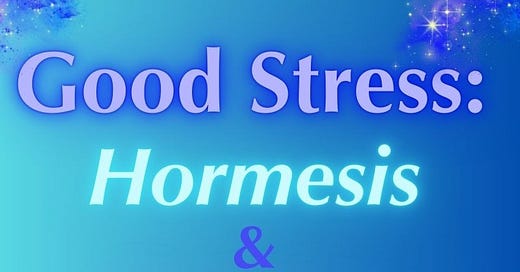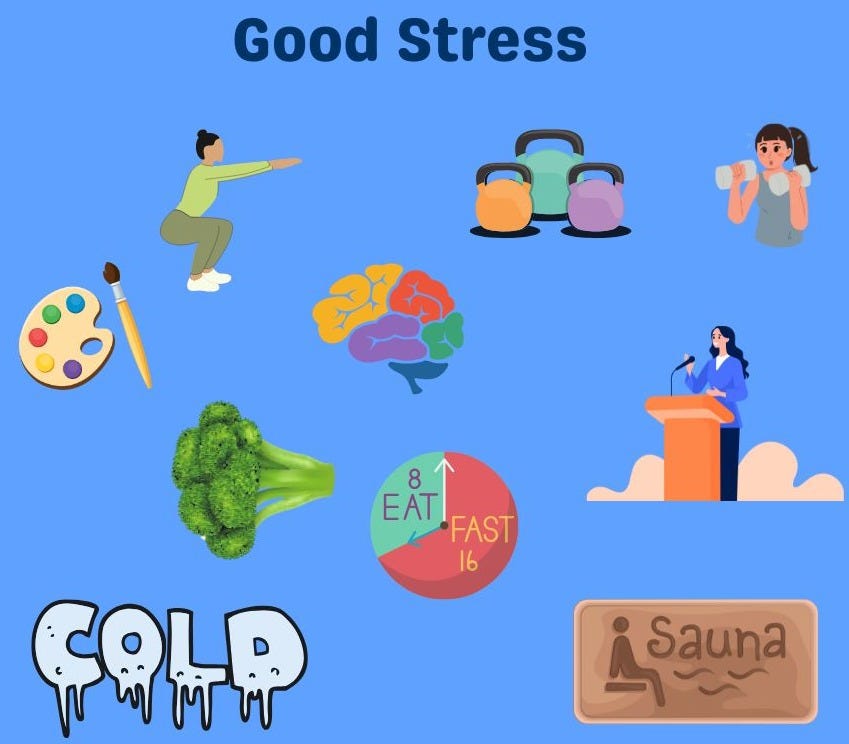April is Stress Awareness Month—and while stress often gets a bad rap, this month we’re flipping the script. What if some stress could actually enhance your health and extend your healthspan?
It’s true! Some kinds of stress can actually add life to our years by increasing the number of years we live in good health, free from chronic disease and disability. So this month, we’ll dive into different forms of good stress that can become essential weapons in your wellness and longevity arsenal.
What Is "Good Stress" and Why Should We Care?
While chronic stress wreaks havoc on our bodies and minds, not all stress is detrimental. In fact, certain types—like hormesis and eustress—are beneficial. These forms of stress enhance resilience, vitality, and even longevity.
🧬 Hormesis: A Little Stress Goes a Long Way
Hormesis refers to the biological principle where low doses of a stressor induce protective mechanisms and positive changes like cellular repair and rejuvenation.
While too much stress is harmful, mild stressors—such as exercise or intermittent fasting—can activate beneficial processes in the body.
Your body responds to these physical challenges by upgrading its defenses. A 2020 meta-analysis published in the journal Aging supports that hormetic stressors activate cellular repair processes, reduce inflammation, and support overall health—all essential components for aging well.
🔑 Key Benefits of Hormesis:
Recent research shows that hormesis provides myriad health and longevity benefits, including:
Cellular Repair and Resilience: Mild stressors such as exercise, fasting, or temperature extremes trigger autophagy (cellular cleanup) and DNA repair—removing damaged components and enhancing cell function.
Reduced Inflammation and Enhanced Metabolism: Hormetic stress boosts insulin sensitivity, reduces chronic inflammation, and promotes fat loss—keys to preventing age-related diseases such as heart disease and neurodegeneration.
Longevity Pathways: Hormesis activates sirtuins and heat shock proteins that rejuvenate cells and improve mitochondrial function.
Increased Stress Resilience: Regular exposure to mild stress builds the body’s capacity to handle future physical and mental stress.
💡 Practical Examples of Hormetic Stress:
🏋️♀️ Exercise
Induces mild oxidative stress → activates repair mechanisms
Improves muscle strength, cardiovascular health, and future stress resilience
Dose matters: moderate = benefit, excessive = harm
🍽️ Intermittent Fasting
Creates metabolic stress → shifts energy source to ketones
Activates autophagy, Nrf2 (a protein that activates your body’s natural antioxidant and detox systems), and AMPK (an energy-sensing enzyme that helps regulate metabolism and promote cellular repair) pathways.
Boosts metabolism, brain function, and resilience
🔥 Heat Exposure (Saunas)
Induces heat shock proteins (HSPs)(protective proteins that help cells recover from stress and keep them functioning properly)
Enhances circulation and detoxification
Supports cardiovascular health
❄️ Cold Exposure (Cold Showers/Cryotherapy)
Activates thermogenesis and boosts norepinephrine
Improves mood, mitochondrial function, and inflammation
🥦 Phytonutrients (like in broccoli)
Cause mild cellular stress through compounds like sulforaphane
Activate detox and repair pathways
Dietary hormesis that builds cellular resilience
In all cases, these mild stressors activate adaptive mechanisms that strengthen the body’s ability to cope with more severe challenges in the future.
🌈 Eustress: The Energizing Stress That Lifts You Up
Eustress, a term coined by endocrinologist Hans Selye, describes positive mental or emotional stress—the kind that motivates and excites you.
Examples of eustress include:
Starting an exciting new project
Learning a challenging skill
Training for your first 5K
Stepping outside your comfort zone
Eustress is closely tied to flow—a state of complete immersion and focus. Research by psychologist Mihaly Csikszentmihalyi shows that frequent flow experiences lead to greater life satisfaction, improved cognitive performance, and a boost in mental well-being.
Studies building on his work, including research published in The Journal of Experimental Psychology, suggest that flow is associated with an optimal stress response, potentially reducing cortisol levels compared to states of distress, while fostering resilience to future challenges. These findings highlight the link between regular flow experiences, positive stress (eustress), and overall psychological and physiological benefits.
✨ Why Good Stress Matters—Especially Now
As we age, our physiological systems naturally slow down. We lose muscle, flexibility decreases, and we sometimes even lose confidence in our own bodies. But small, consistent doses of good stress can:
💓 Support cardiovascular health
🔥 Reduce inflammation
🍎 Improve insulin sensitivity
💪 Promote muscle retention and bone density
🧠 Boost cognitive health and emotional resilience
Research, including studies from The Journals of Gerontology: Series A and related geroscience literature, supports the compelling notion that hormetic stress—such as repeated mild challenges like heat or exercise—and eustress interventions can slow aspects of biological aging while enhancing functional capacity.
For instance, findings suggest that hormetic stressors bolster cellular resilience and reduce molecular damage, contributing to a slower aging process, while interventions like moderate exercise improve physical and cognitive function. In essence, these approaches help us not only live longer, but increase vitality along the way.
In short: they help us live not just longer, but better.
Your April Good-Stress Menu
Here’s what we’ll be exploring this month:
✨ Saunas (Traditional and Infrared)
What it does: Delivers gentle heat therapy.
Why you'll love it: Boosts circulation, detoxification, and relaxation.
❄️ Cold Therapy (Showers & Plunges)
What it does: Creates revitalizing temperature contrast.
Why you'll love it: Increases energy, mood, and immune function.
🍽️ Intermittent Fasting
What it does: Gives digestion a break.
Why you'll love it: Recharges cellular health and metabolic flexibility.
🏋️♀️ Moderate Exercise
What it does: Creates just-right physical challenge.
Why you'll love it: Builds strength and cardiovascular health.
🧩 Novel Challenges
What it does: Stimulates neuroplasticity.
Why you'll love it: Keeps your brain sharp and creative.
🎨 Creative Flow
What it does: Engages focused attention.
Why you'll love it: Delivers joy, purpose, and cognitive benefits.
Each of these practices taps into either hormesis or eustress, helping us feel more alive, resilient, and in control of how we age.
🛠️ How to Start Adding Good Stress: Your Simple Action Plan
✅ Start small: Choose one new challenge this week that gently nudges you out of your comfort zone.
✅ Build gradually: Aim for 10–15 minutes of mild stress exposure, 2–3 times per week. (Stay tuned for detailed tips in upcoming posts!)
✅ Track how you feel: Sleeping better? More energy? Clearer thinking? That’s the goal!
✅ Check in with your doctor: Especially for heat, cold, or fasting; your provider can help you make safe choices.
💬 Let’s Make April Your Resilience Reset
Good stress isn’t a fad—it’s a science-backed way to stay strong, sharp, and vibrant as we age.
By embracing small, manageable challenges, we tell our bodies and minds:
“I’m still growing, still capable, still evolving.”
✨ Your Turn:
What’s one form of eustress in your life—an energizing, flow-inducing challenge you’re excited to try?
Share in the comments below—I’d love to hear what you’re exploring this month!
📩 Coming Up Next:
Don’t miss my deep dive into the health benefits of saunas and how they can transform your well-being.
Here’s to leaning into good stress for a longer, more joyful life.
Let’s thrive together!






so interesting!!
Interesting Daria! I've been intermittent fasting for about 6 or 7 years or so. It helps me keep my eating my in check, especially the late night snacking, which no longer happens.